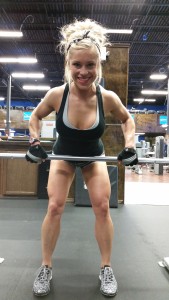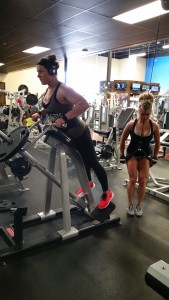Fitness myths and the bathing suit pursuit
by Nancy B. Loughlin
Published in News Press on July 14, 2015
“I want to look good in a bathing suit.”
Personal trainer Magen Wooley hears this dream daily from new clients, and she smiles gently.
People hit the gym because they want Michelle Obama arms, Channing Tatum abs or a Jennifer Lopez butt.
“But, you can’t just order up body parts,” Wooley said. The education process must now begin.
She says: “Listen.”
Number One: Toning is a myth. When you work out, your muscles don’t get smaller and tighter; they get bigger. It is for this reason that some trainers recommend that you not do abdominal work at the beginning of a workout program. Before you lose any fat, your stomach will actually look bigger if you’re hammering away with core work. If you want the defined, firm rack in your core, you have to lose the fluffy fat on top of it.
Likewise, the phrase “lengthening the muscle” is also misleading because muscles don’t get longer. They are attached to tendons that attach to your bones, so they aren’t going anywhere. As you lose body fat, you will be leaner, but the “longer” is an illusion.
Also, don’t underestimate genetics when you compare your appearance to someone else. You are who you are. Ripped, beefy quads and that six-pack may not be in the cards for you no matter how hard you crunch and restrict your diet. About that diet…
Number Two: About 75% of how you look is what you eat.
For many, working out is a way to compensate for the lack of self-control evident in overeating and binging on sugar and fat. Grinding at the gym becomes part of the self-destructive pattern. A Big Mac meal replete with fries and a Coke is around 1,100 calories, and don’t forget the morning Mocha clocked in at 360 calories.
Workouts burn calories but not that many calories. A 26.2-mile marathon will burn approximately 2,600 calories given the 100-calories-per-mile estimate (not including the afterburn). How does your workout’s intensity and duration compare to running/jogging 26.2 miles?
It’s about input and output. The idea that you can go to the gym for an hour and pound out that many excess calories is delusional.
By the way, your body decides which fat leaves the building, not you. You can’t just diet your ass.
Number Three: You have to build muscle if you want to show it off. Not only do you have to restrict your caloric intake, you have to do weight training so you can see the muscles in the first place.
The fitness novice is often consumed with the choice of more reps at lighter weight vs. fewer reps with heavier weight. Wooley says it just doesn’t matter.
The goal with weight training is to fatigue the muscle. It could take 100 reps with a five-pound dumbbell or 15 reps with 20 pounds.
You’ve seen the high drama around the free weights: big guys and gals pumping iron, growling savages, throwing their weights to the ground and strutting to the mirrors with brutish satisfaction. You roll your eyes and continue your dainty reps.
But they have something to teach you.
Sure, go for the 15 reps with 20 pounds, but if you aren’t grimacing by number 13, grunting by 14, gritting your teeth at 15 with a number 16 being impossible, you’re just fooling around. You’re supposed to feel the good sore the next day. That’s how you know you’re building muscle tissue.
“Push through until failure,” Wooley, a competitive women’s bodybuilder, says.
Number Four: So you don’t want to get big? Contrary to the bulking-up fears that lead many women to confine themselves to cardio, simple weight training will not make you look like the Hulk.
Bodybuilding is only for the dedicated and disciplined. Developing the necessary muscle maturity would take you years of workouts and specific diets to tear down and build up muscle tissue. You will not bulk up.
Number Five: Looking good in a bathing suit is nice, but you might consider having a fitness goal outside of your appearance.
There are five elements of fitness: cardiovascular, muscular strength, muscular endurance, flexibility and body composition. Are you looking to build strength or are you really interested in increasing muscle mass? Endurance and speed are different, so which one do you want to enhance? You may dream of playing tennis or golf, so how is your coordination? As you age, flexibility and balance become challenging, so take inventory of your leisure time activities and daily tasks.
How could you make your body your tool for living, and how can your workouts help you?
But, if you are fixated on the swimsuit, the best place to start is in the kitchen.


